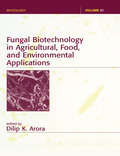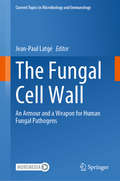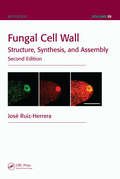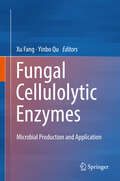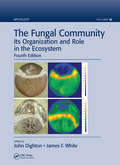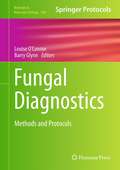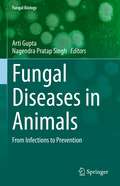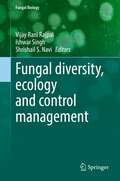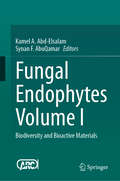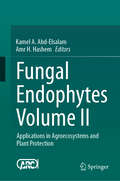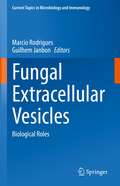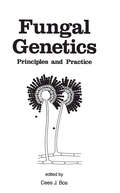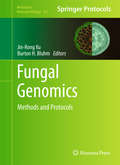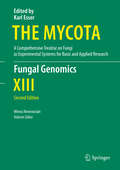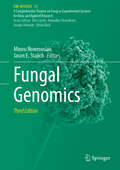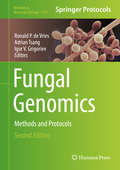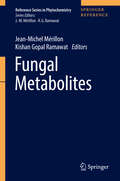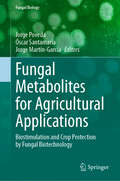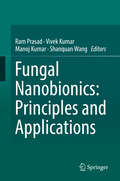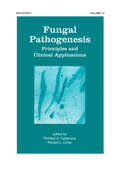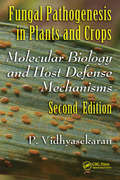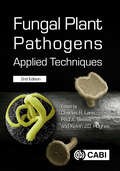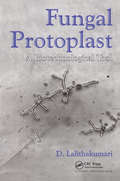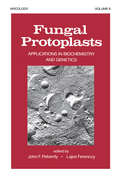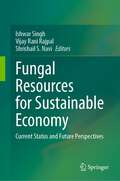- Table View
- List View
Fungal Biotechnology in Agricultural, Food, and Environmental Applications (Mycology Ser. #Vol. 21)
by Dilip K. AroraContributions from 80 world-renowned authorities representing a broad international background lend Fungal Biotechnology in Agricultural, Food, and Environmental Applicationsfirst-class information on the biotechnological potential of entomopathogenic fungi and ergot alkaloids, applications of Trichoderma in disease control, and the d
The Fungal Cell Wall: An Armour and a Weapon for Human Fungal Pathogens (Current Topics in Microbiology and Immunology #425)
by Jean-Paul LatgéThis book illustrates, that the fungal cell wall is critical for the biology and ecology of all fungi and especially for human fungal pathogens. Readers will learn, that the composition of the fungal cell wall is a unique structure, which cannot be found in the human host. Consequently, the chapters outline, how the immune systems of both animals and humans have evolved to recognize conserved and unique elements of the fungal cell wall. As an application example, the authors also show, that the three-dimensional structures of the cell wall are excellent targets for the development of antifungal agents and chemotherapeutic strategies. With the combination of biological findings and medical outlooks, this volume is a fascinating read for scientists, clinicians and biomedical students.
Fungal Cell Wall: Structure, Synthesis, and Assembly, Second Edition (Mycology)
by José Ruiz-HerreraFungal Cell Wall: Structure, Synthesis, and Assembly, Second Edition is a compendium of information on the chemical structure, synthesis, and organization of the cell wall of fungi. Reviewing the past 20 years of research in the field, it discusses experimental evidence that demonstrates the role of the cell wall in the growth, development, morphog
Fungal Cellulolytic Enzymes: Microbial Production And Application
by Yinbo Qu Xu FangThe book provides an overview of the current knowledge on cellulolytic enzymes and their applications. It summarizes the mechanisms of synthesis and hydrolysis of cellulolytic enzymes, industrial fungal strains, genetic engineering of fungal strains and application of cellulolytic enzymes. This book will be a useful reference for researchers and bioengineering experts engaged in lignocelluloses biodegradation, biomass utilization, enzyme production and fungal molecular biology.
The Fungal Community: Its Organization and Role in the Ecosystem, Fourth Edition (Mycology)
by John Dighton James F. White"…a number of chapters provide excellent summaries of the modern methods available for studying fungal ecology, along with those more traditional methods that are still extremely valuable…overall it is a hugely valuable compendium of fungal ecology research. It is a must for the library shelf." -Lynne Boddy, Cardiff University, UK, Mycological Research, 2006"These 44 chapters are an excellent starting point for anyone interested in fungal communities, in the broadest sense of the term. It is a book for dipping into…may be the last comprehensive treatment of fungal communities before the molecular revolution."-Meriel Jones, University of Liverpool, UK, Microbiology Today "… the scope of the work is tremendous. … Excellent chapters providing overviews of methods … provide a snap shot of the current approaches used to understand fungal communities at several levels of organization. This book should probably be on the shelf of every student of mycology, and many ecologists too. For all students, this book should be a valuable resource and source of inspiration." -Daniel Henk, Imperial College Faculty of Medicine, London, in Inoculum, Vol. 59, No. 3, May 2008 "Thorough taxonomic and subject indices further aid the reader in navigating through multiple authors’ treatments of subjects of interest." - Anthony Amend, Department of Botany, University of Hawaii at Manoa in Economic Botany, V. 61 In all subjects in science, new findings and the use of new technologies allow us to develop an ever-greater understanding of our world. Expanded and updated coverage in the fourth edition includes: Adds new sections on Integrating Genomics and Metagenomics into Community Analysis, Recent Advances in Fungal Endophyte Research, Fungi in the Built Environment, and Fungal Signaling and Communication Includes a broader treatment of fungal communities in natural ecosystems with in-depth coverage of fungal adaptations to stress and conservation Expands coverage of the influence of climate change on fungi and the role of fungi in organically polluted ecosystems Includes contributions from scientists from 20 nations to illustrate a true global approach for bridging gaps between ecological concepts and mycology
Fungal Diagnostics
by Barry Glynn Louise O'ConnorInvasive fungal infections are a significant cause of morbidity and mortality. Over the past decade there has been a concerted effort to develop reliable methods for the detection of such infections. In Fungal Diagnostics: Methods and Protocols, expert researchers in the field detail the introduction of new technology into a diagnostic setting include ease of use, and rapid turnaround time without compromising sensitivity and specificity. Focusing specifically on fungal detection in clinical settings, fungal diagnostics including, environmental testing, agriculture and food production and veterinary diagnostics. Written in the highly successful Methods in Molecular BiologyTM series format, chapters include introductions to their respective topics, lists of the necessary materials and reagents, step-by-step, readily reproducible laboratory protocols, and key tips on troubleshooting and avoiding known pitfalls. Authoritative and practical, Fungal Diagnostics: Methods and Protocols seeks to aid scientists into the further study of diagnostic and detection of fungi.
Fungal Diseases in Animals: From Infections to Prevention (Fungal Biology)
by Arti Gupta Nagendra Pratap SinghThe importance of fungal infections in both human and animals has increased over the last few decades. This book presents an overview of the different categories of fungal infections that can be encountered in animals (including lower vertebrates) originating from environmental sources with or without transmission to humans. In addition, the endemic infections with indirect transmission from the environment, the zoophilic fungal pathogens with near-direct transmission, the zoonotic fungi that can be directly transmitted from animals to humans, mycotoxicoses and antifungal resistance in animals will also be discussed. This book includes case studies and reviews the current state of knowledge on the mechanism of fungal attraction, recognition, infection, extracellular hydrolytic enzymes and pathogenesis of nematophagous fungi. The book also covers diagnostics, fungal formulations, as well as prevention methods. It discusses strategies to access the fungal pathogen groups, metagenomic analyses, genomics, secretomics, metabolomics, proteomics and transcriptomics. In addition, pathogen description, understanding, distribution and recent research results are provided.
Fungal diversity, ecology and control management (Fungal Biology)
by Vijay Rani Rajpal Ishwar Singh Shrishail S. NaviThis edited volume provides comprehensive and latest information on the fungal biodiversity in its morphological characters, bioactive molecules, pathogenicity and virulence, and its impacts on crop production and sustainable management of agricultural productivity towards resolving global food security issues. The increasing number of infectious fungal diseases are regarded as threats to agricultural productivity and global food security. The efforts done by scientists to inventories the fungal diversity and identification of fungal species contributing as pathogens towards many plant and human diseases have been compiled in the present volume. The identification of the potential fungal pathogens is a prerequisite for an effective disease control management program. Also important is to understand the complex interactions between the host-pathogen and the environment. The book dwells on insights on the aforementioned aspects. The book also includes articles on ecological significance of fungi and fungal antagonists used as biocontrol agents on other pathogens. This compilation is useful to scientists working in similar areas as well as to undergraduate and graduate students keen on getting updated information on the subject. Scientists involved in agricultural research, crop management, and industries that manufacture agrochemicals may also find it useful read.
Fungal Endophytes Volume I: Biodiversity and Bioactive Materials
by Kamel A. Abd-Elsalam Synan F. AbuQamarThis book explores the ecology and evolutionary dynamics of fungi. It focuses on identifying new metabolites extracted from endophytic fungi through genetic methods and bioassay-guided isolation. Detailed procedures for producing fungal endophyte metabolites for commercial use are also discussed. This book covers the diverse traits of fungal endophytes and their interactions with host plants, providing tactical insights into how these organisms can be utilized to their full potential in pharmaceutical, agricultural and industrial applications. This interdisciplinary reference is suitable for students and researchers in fields such as materials science, biology, plant science, microbiology, plant physiology and biotechnology. It is also useful for agri-food environmental scientists and agrochemical companies. In addition, the book offers valuable information for industrial scientists working on the synthesis and application of fungal secondary metabolites in plant science.
Fungal Endophytes Volume II: Applications in Agroecosystems and Plant Protection
by Kamel A. Abd-Elsalam Amr H. HashemThis book explores applications of endophytic fungi in agriculture and plant protection. It provides insights into the potential of these fungi in developing environmentally friendly and sustainable agricultural techniques. This book discusses the use of endophytic fungi as biocontrol agents against plant infections and stressors. It is targeted at farmers, plant pathologists, agricultural researchers, biotechnology experts, and students of biology and agronomy who are interested in learning more about the expanding applications of fungal endophytes in agriculture and plant health. The book examines the role of endophytes and their bioactive metabolites in agricultural yield, plant growth promotion, and plant defence against stress and disease.
Fungal Extracellular Vesicles: Biological Roles (Current Topics in Microbiology and Immunology #432)
by Marcio Rodrigues Guilhem JanbonThis book provides an in-depth overview on the manifold functions of fungal extracellular vesicles (EV) which span from cell-to-cell communication, pathogenicity and stimulation of host’s immunity to export of hundreds of biomolecules. The book summarizes the present knowledge on the impact of extracellular vesicles on fungal biology. Extracellular vesicles participate in fundamental biological processes in all living cells but only during the last 15 years the production and functions of EVs were identified and studied in fungal species too. Up to date more than 50 independent studies have shown that extracellular vesicles are produced by at least 20 fungal species. The book addresses researchers and advanced students in Microbiology, Mycology and Biotechnology.
Fungal Genetics: Principles and Practice
by Cees J. BosThis is a concise guide to the combined use of classical and molecular methods for the genetic analysis and breeding of fungi. It presents basic concepts and experimental designs, and demonstrates the power of fungal genetics for applied research in biotechnology and phytopathology. Case studies of Saccharomyces cerevisiae, Candida albicans, Aspergillus niger, Neurospora crassa, Podospora anserina, Phytophthora infestans and others are included.
Fungal Genomics
by Burton H. Bluhm Jin-Rong XuHaving experienced unprecedented growth since the turn of the millennium, the dramatic expansion of resources and techniques in fungal genomics is poised to fundamentally redefine the study of fungal biology. In Fungal Genomics: Methods and Protocols, expert researchers explore the three most likely fronts upon which the field will advance: the sequencing of more and more fungal genomes, the mining of sequenced genomes for useful information, and most importantly, the use of genomics sequences to provide a foundation for powerful techniques to explain biological processes. Much of the book is dedicated to explaining established and emerging genomics-based technologies in filamentous fungi, including gene expression profiling techniques, techniques for fungal proteomics as well as various case studies that could be adapted to a wide range of fungi. Written in the highly successful Methods in Molecular BiologyTM series format, protocol chapters include brief introductions to their respective topics, lists of the necessary materials and reagents, step-by-step laboratory protocols, and key unpublished tips, potential pitfalls, common mistakes, and special considerations based on the unique experiences of the contributors. Authoritative and cutting-edge, Fungal Genomics: Methods and Protocols provides fungal biologists at any stage of their careers a user-friendly resource for fungal genomics, especially as readers branch out into unfamiliar but exciting new areas of study.
Fungal Genomics
by Minou NowrousianThe volume is divided into four sections, the first of which, Genome Sequences and Beyond, illustrates the impact of genome-based information and techniques on research ranging from model organisms like yeast to less-studied basal fungal lineages. Furthermore, it highlights novel types of analysis made possible by multi-genome comparisons as well as the impact of genomics on culture collections and vice versa. The second section, Cell and Developmental Biology, addresses questions that are important for fungal biology, e. g. the development of fungal fruiting bodies, and biology in general, e. g. chromatin organization and circadian rhythms. The third section, Genomics for Biotechnology, covers the search for plant biomass-converting enzymes in fungal genomes and work with industrially important fungi. The fourth section, focusing on Pathogenicity, offers chapters on the genomic analysis of plant and animal/human pathogens. It illustrates how genomics at all levels, from genome to metabolome, is used to study mechanisms of the interactions of fungi with other organisms.
Fungal Genomics (The Mycota #13)
by Minou Nowrousian Jason E. StajichThis fully revised 3rd edition of Fungal Genomics highlights the impact of genomics on the field of fungal biology in four sections: Part I Genome Sequences and Beyond: Examines the impact of genome-based information and techniques on research ranging from the discovery of giant transposons to the analysis of less-studied extremotolerant fungi as well as studies of three-dimensional chromatin organization in fungi. Part II Cell and Developmental Biology: Explores advances in high-throughput genetics/genomics and RNA editing in fungi, the role of codons in gene regulation, and the analysis of epigenetic regulation in early-diverging fungi. Part III Biotechnology: Covers the search for plant biomass-converting enzymes in fungal genomes and work with industrially important fungi. Part IV Interactions - Symbioses, Mutualisms, and Pathogens: Explains the genomic analysis of the emerging human pathogen Candida auris as well as genomic signatures in ectomycorrhizal fungi. This book is a must-read for anyone interested in the exciting field of fungal genomics.
Fungal Genomics: Methods and Protocols (Methods in Molecular Biology #1775)
by Ronald P. de Vries Adrian Tsang Igor V. GrigorievThis volume details protocols covering nearly all aspects of fungal genomics. New and updated chapters guide the reader through experimental genomics, biotechnologies, and the analysis and processing of data. Written in the highly successful Methods in Molecular Biology series format, chapters include introductions to their respective topics, lists of the necessary materials and reagents, step-by-step, readily reproducible laboratory protocols, and tips on troubleshooting and avoiding known pitfalls. Authoritative and practical, Fungal Genomics : Methods and Protocols, Second Edition aims to ensure successful results in the further study of this vital field.
Fungal Metabolites
by Jean-Michel Mérillon Kishan Gopal RamawatThis handbook compiles authoritative information about fungal metabolites and their chemistry and biotechnology. The first in the reference work series "Phytochemicals", and written by a team of international expert authors, this book provides reference information ranging from the description of fungal natural products, over their use e. g. as anticancer agents, to microbial synthesis, even spanning to the production of secondary metabolites on industrial scale. On the other hand it also describes global health issues related to aflatoxin production in foods and agriculture, including perspectives for detoxification. The handbook characterizes different compound classes derived from fungal secondary metabolites, like ergot alkaloids and aflatoxins. The discussion puts a special emphasis on how potentially useful compounds can be obtained and what applications they can find, on the one hand, and how potential dangers can be encountered on the other hand. The comprehensive chapters in this handbook will thus appeal to readers from diverse backgrounds in chemistry, biology, life sciences, and even medicine, who are working or planning to work with fungal (secondary) metabolites and their application. They provide the readers with rich sources of reference information on important topics in this field.
Fungal Metabolites for Agricultural Applications: Biostimulation and Crop Protection by Fungal Biotechnology (Fungal Biology)
by Jorge Poveda Óscar Santamaría Jorge Martín-GarcíaThis book delves into the fascinating world of fungal metabolites and their biotechnological potential for sustainable agriculture. Through this book, readers will learn about the production and characterization of metabolites by endophytic and rhizospheric fungi, including filamentous fungi like Trichoderma, Penicillium, and Aspergillus, as well as mycorrhizal fungi and yeasts. The chapters cover topics such as the promotion of plant growth, increased tolerance to abiotic stresses, and biological control through the application of fungal metabolites. Expert contributors provide an in-depth analysis of how these metabolites can be produced in bioreactors or applied directly as agricultural bioinoculants. Particular attention is given to the environmental and health benefits of using fungal metabolites in crop improvement. Researchers in the field of agricultural biotechnology, plant sciences, and environmental sustainability will find this book invaluable. It offers a comprehensive discussion from biological, chemical, and applied perspectives, making it a must-read for anyone interested in advancing sustainable agriculture practices.
Fungal Nanobionics: Principles and Applications
by Ram Prasad Vivek Kumar Manoj Kumar Shanquan WangFungal nanobionics has great prospects for developing new products with industrial, agriculture, medicine and consumer applications in a wide range of sectors. The fields of chemical engineering, agri-food, biochemical, pharmaceuticals, diagnostics and medical device development all employ fungal products, with fungal nanomaterials currently used in a wide range of applications, ranging from drug development to food industry and agricultural sector. The fungal agents emerge as an environmentally friendly, clean, non‐toxic agent for the biogenic metal nanoparticles and employs both intracellular and extracellular methods. The simplicity of scaling up and downstream processing and the presence of fungal mycelia affording an increased surface area provide key advantages. In addition, the larger spectrum of synthesized nanoparticle morphologies and the substantially faster biosynthesis rate in cell-free filtrate (due to the higher amount of proteins secreted in fungi) make this a particularly enticing route. Understanding the diversity of fungi in assorted ecosystems, as well as their interactions with other microorganisms, animals and plants, is essential to underpin real and innovative technological developments and the applications of metal nanoparticles in many disciplines including agriculture, catalysis, and biomedical biosensors. Importantly, biogenic fungal nanoparticles show significant synergistic characteristics when combined with antibiotics and fungicides to offer substantially greater resistance to microbial growth and applications in nanomedicine ranging from topical ointments and bandages for wound healing to coated stents.
Fungal Pathogenesis: Principles and Clinical Applications
by Richard CalderoneStresses molecular and biochemical studies of opportunistic and frank fungal pathogens!This book gives a comprehensive overview of human pathogenic fungi that offers a current and concise survey of virulence factors, host responses and recognition, treatment and diagnosis of infections, invasive enzymes, intracellular survival, morphogenesi
Fungal Pathogenesis in Plants and Crops: Molecular Biology and Host Defense Mechanisms, Second Edition (Books in Soils, Plants, and the Environment)
by P. VidhyasekaranDramatic progress in molecular biology and genetic engineering has recently produced an unparalleled wealth of information on the mechanisms of plant and pathogen interactions at the cellular and molecular levels. Completely revised and expanded, Fungal Pathogenesis in Plants and Crops: Molecular Biology and Host Defense Mechanisms, Second Edition
Fungal Plant Pathogens: Applied Techniques
by Kinda Alraiss Rachel Barker Victoria Barton Lucy Carson-Taylor David Cooke Ashleigh Elliot David Galsworthy Steve Hendry Anthony Kermode Paul Kirk Michael Long Aiga Ozolina Ana Pérez-Sierra Belinda Phillipson Matthew J Ryan David Smith Christopher Thornton Jenny Tomlinson Joan WebberThis substantially updated edition now in full colour provides key techniques used when working with fungal and fungal-like plant pathogens. As a practical manual it also deals with disease recognition, detection and identification of fungi, plus methods to characterise and curate fungi and handle them under quarantine and quality assurance systems. Furthermore, this new edition includes significant updates with respect to: - Greater awareness and concern internationally about plant health and biosecurity. - Molecular biology - next generation sequencing and in-field detection. - Improved opportunities for surveillance and detection in diverse substrates. - Changes in taxonomy and reference to current fungal plant pathogens. - New chapters on tree health, and public awareness, outreach and communications. Fungal Plant Pathogens: Applied Techniques, 2nd edition provides a valuable guide to investigating fungal plant diseases and interpreting laboratory findings for postgraduate and advanced undergraduate students, extension plant pathologists, consultants and advisers in agriculture, forestry and horticulture, and the food supply chain.
Fungal Protoplast: A Biotechnological Tool
by D LalithakumariBetter validation of indigenous domestic animal genetic resources is becoming more important with regard to the potential of livestock for poverty alleviation and income generation. To improve indigenous breeds for sustainable income and employment generation, the methods to be employed are the same as developed in systematic breeding programs, be it for cross-breeding or selective breeding within a specific breed. This book systematically introduces the reader to the breed improvement theory and illustrates the theory with practical examples and case studies. The book is addressed to animal science teachers, to undergraduate and postgraduate students as well as to decision makers in the state and central livestock departments.
Fungal Protoplasts: Applications in Biochemistry and Genetics
by John F. PeberdyUntil now, information on fungal protoplasts has been scattered throughout various sources. With authoritative reviews of protoplast isolation and applications in fungal biology research, Fungal Protoplasts: Applications in Biochemistry and Genetics is the first volume devoted to a major area in experimental mycology-fungal protoplasts.Written by 18 pioneering experts, this unmatched, illustrated reference presents well-established knowledge of protoplast research as well as newer ideas and methods. The book encompasses advances in protoplast isolation techniques and methodology, uses of protoplasts in physiological, biochemical, and genetic studies, and developments in protoplast fusion that form the basis for transformation and gene cloning experiments, including applications in industrial biotechnology. This fact-filled book also features end-of-chapter bibliographies for further research.
Fungal Resources for Sustainable Economy: Current Status and Future Perspectives
by Ishwar Singh Vijay Rani Rajpal Shrishail S. NaviThis edited book provides a comprehensive account of the new developments in various facets of fungal biology related to the impact and application of fungi on the sustainable economy. The book consists of 24 chapters distributed under five sections written by active researchers and academicians from India and abroad. The five sections of the book are- 1. Fungi in Sustainable Economy, 2. Fungal Resources: Current and Potential Industrial Applications, 3. Fungal Resources: Current and Potential Agricultural Applications, 4. Fungi and their Secondary metabolites: Implications and 5. Fungi: Burden to health and Indoor Environment.The book explores the utility of fungi as food, enzymes, organic compounds, nutraceuticals, pharmaceuticals and agricultural productivity promoter. It also highlights the negative fungal impacts on food production, health and environment. The book is useful to postgraduate students studying mycology, plant pathology, crop protection, agricultural sciences, and plant sciences. In addition, scientists involved in biological and agricultural research, crop management, and various industries that manufacture or utilize fungal products on a small to large scale shall also find the book helpful.
